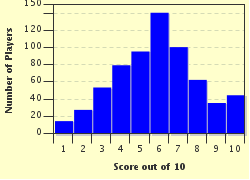Quiz Answer Key and Fun Facts
1. Three English professors developed the first instruments to study earthquakes. How did these instruments study earthquake movement?
2. What is the depth of a shallow-focus earthquake?
3. Different types of seismic waves are generated by earthquakes. What is the name of the wave that pushes and pulls similar to the motion of a slinky?
4. Why was the 2003 earthquake in Bam, Iran significant for historians?
5. Who developed the scale for measuring the power of an earthquake?
6. In the 1880s, the first reliable seismic instruments were developed in which country?
7. Name a well known fault that separates the Pacific plate from the North American plate.
8. What is the location on the Earth's surface directly above the place where an earthquake originates called?
9. In the twentieth century, along the coast of which country in South America did the largest earthquake occur?
10. If there are several earthquakes in a row, what is the name of the largest of these earthquakes?
Source: Author
trevor1968
This quiz was reviewed by FunTrivia editor
crisw before going online.
Any errors found in FunTrivia content are routinely corrected through our feedback system.

